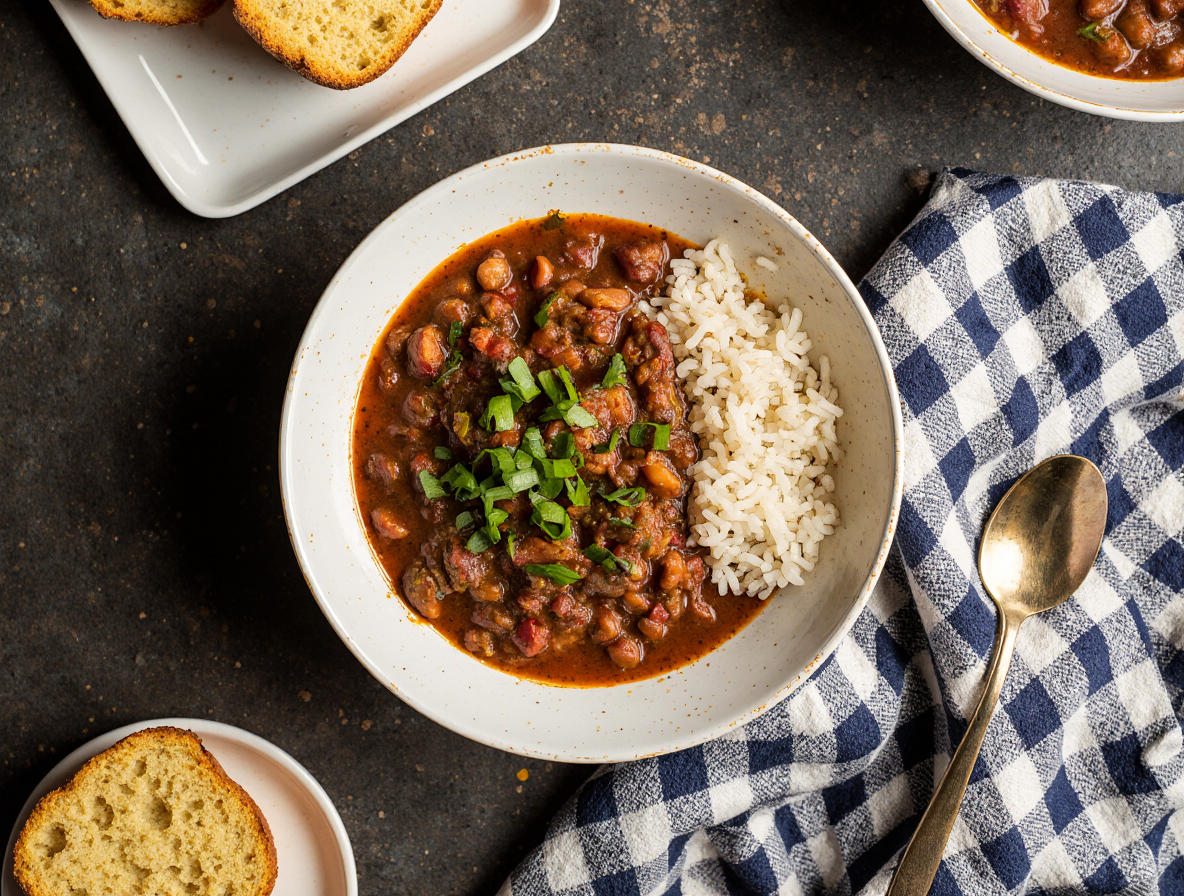The Secret Behind Perfect Louisiana Red Beans and Rice Recipe (Chef-Tested)
Red beans and rice recipe lovers know this dish is more than just a meal—it’s a cherished tradition. Traditionally in New Orleans, red beans were served on Monday as families did laundry, letting the pot simmer while washing got done. This authentic Louisiana red beans and rice is a budget-friendly recipe with incredible Cajun flavor, proving why it has remained a staple for generations.
Not only is Louisiana red beans and rice a versatile dish that can act as either a main or side course, but this classic has also been filling hungry bellies on a dime for centuries. In fact, similar recipes have been reader favorites for almost 15 years, demonstrating that good food truly stands the test of time. With each serving providing 630 calories, 24g of protein, and 79g of carbs, this hearty dish delivers substantial nutrition alongside its rich flavors.
For anyone with roots in southern Louisiana, red beans and rice holds special significance—everyone thinks their mom makes the best version. In this guide, we’ll explore the secrets behind creating a perfect, authentic Louisiana red beans and rice that might just rival those family recipes. From selecting the right ingredients to mastering the slow-cooking process that can take up to 3 hours, we’ll cover everything you need to know about this Monday night, New Orleans tradition.
Choosing the Right Ingredients for Authentic Louisiana Red Beans and Rice
The secret to an authentic Louisiana red beans and rice recipe starts with selecting the right ingredients. Unlike many dishes where substitutions work fine, true Louisiana style red beans and rice demands specific components that create its distinctive, comforting flavor.
Red beans vs. kidney beans: what’s the difference?
Though often confused, red beans and kidney beans are actually different legumes. Red beans are smaller, rounder, and have a subtly nutty flavor, whereas kidney beans are larger with thicker skins and a deeper red color. Although both can work in your recipe, traditionalists prefer small red beans for authentic Louisiana red beans and rice. Interestingly, some locals believe kidney beans are more Cajun while small red beans have Caribbean influences.
The holy trinity: onion, celery, and bell pepper
At the foundation of almost every Louisiana recipe sits “the holy trinity” – equal parts onion, celery, and green bell pepper. Unlike traditional French mirepoix which uses carrots, the holy trinity substitutes bell peppers. This combination creates the aromatic base that defines Cajun and Creole cooking, appearing in classics like gumbo, jambalaya, and étouffée. Some chefs refer to garlic as “the pope” – an honorary fourth member of this crucial flavor base. When preparing red beans, these vegetables eventually break down completely during the long simmer, creating a rich, creamy gravy.
Best meats to use: andouille sausage, ham hocks, or bacon
Authentic Louisiana red beans and rice gets much of its distinctive flavor from smoked meats. Andouille sausage, a pre-cooked smoked pork sausage, stands as the most traditional choice, lending spicy, cured flavor and rich fattiness. Ham hocks provide smokiness plus gelatin that adds body to the liquid. Bacon (particularly thick-cut) offers both flavor and valuable fat for sautéing the trinity. Some recipes even include pickled pork shoulder for brightness. Each meat component contributes unique characteristics, creating layers of flavor impossible to achieve otherwise.
Spices and herbs that define the flavor
The final touch comes from a carefully selected blend of spices. Bay leaves are non-negotiable, appearing in virtually every traditional recipe. Beyond that, most recipes include some combination of:
- Dried thyme and oregano
- Black pepper and cayenne for heat
- Creole or Cajun seasoning (which typically contains paprika, garlic powder, and onion powder)
- Fresh parsley and green onions added toward the end of cooking
Fresh herbs should be added in stages to maximize flavor, with some reserved for finishing the dish.
Soaking and Prepping the Beans
Preparing dried beans properly makes all the difference in your authentic Louisiana red beans and rice recipe. The preparation stage, specifically soaking, is often debated among chefs but remains a crucial step for achieving that perfect creamy texture.
Why soaking matters
Soaking dried beans before cooking offers several important benefits. First, it significantly reduces cooking time, allowing the beans to absorb water gradually and cook more evenly. Furthermore, properly soaked beans develop better texture with fewer split skins during the cooking process.
Many chefs maintain that soaking helps break down complex sugars called oligosaccharides that can cause digestive discomfort. An overnight soak can dissolve between 75% to 90% of these sugars into the soaking water. Consequently, discarding this soaking liquid and rinsing the beans afterward can make your final dish more digestible.
Overnight soak vs. quick soak methods
The traditional overnight method involves covering beans with cold water (about 2-3 inches above the beans) and letting them sit for 8-16 hours. Most experts recommend soaking for a minimum of 6 hours, with 10 hours being the maximum for optimal results.
Alternatively, if you’re short on time, the quick-soak method works effectively:
- Sort and rinse the beans
- Cover with cold water in a large pot
- Bring to a rolling boil for 2-3 minutes
- Remove from heat, cover, and let sit for 1 hour
- Drain and rinse before cooking
Some chefs prefer the quick-soak method not just for convenience but also for flavor enhancement. Notably, beans soaked using this method maintain excellent taste while reducing cooking time by at least an hour.
How to sort and rinse beans properly
Before soaking, sorting and rinsing are essential steps. Spread beans on a flat surface to identify and remove any stones, damaged beans, or debris. Subsequently, place them in a colander and rinse thoroughly under cold running water to remove field dust and potential contaminants.
Remember not to rinse beans until you’re ready to start soaking, as moisture will initiate the rehydration process prematurely. Additionally, recent studies suggest that adding salt to the soaking water helps beans cook more evenly by replacing magnesium and calcium ions in the bean skins.
Step-by-Step Cooking Process for Louisiana Style Red Beans and Rice
The magic of Louisiana style red beans and rice happens in the pot, where time and technique transform simple ingredients into something extraordinary. This careful cooking process is what creates that distinctive creamy texture and depth of flavor that defines authentic Louisiana red beans and rice.
Sautéing the aromatics and meats
Initially, heat oil or bacon fat in a large Dutch oven over medium heat. Many chefs begin by browning sliced andouille sausage to render its flavorful fat. Once browned, remove the sausage with a slotted spoon and set aside. Next, add the holy trinity—onions, bell peppers, and celery—to the rendered fat and sauté until soft and translucent, typically 5-7 minutes. Towards the end, add minced garlic and cook for just one more minute until fragrant.
Simmering the beans to perfection
After the aromatics have softened, return the sausage to the pot along with any additional smoked meats like ham hocks. Add your soaked, drained beans, bay leaves, and enough fresh water to cover them. Bring the mixture to a boil, then reduce to a simmer. Cover and cook for 1.5-2.5 hours, stirring occasionally to prevent sticking. The cooking time varies based on bean freshness and desired tenderness.
Smashing beans for a creamy texture
Once the beans are tender, the secret to achieving that signature creamy consistency is to mash some against the side of the pot. Take a wooden spoon and press about 1/4 of the beans against the pot’s side. Alternatively, remove a cup of beans, mash them separately, then return them to the pot. This technique releases starches that thicken the liquid into a rich, velvety sauce without needing additional thickeners.
Cooking the rice the right way
Meanwhile, prepare your rice about 30 minutes before the beans finish. Rinse long-grain white rice until water runs clear, then combine 1.5 cups rice with 3 cups water in a saucepan. Bring to a boil, reduce heat to low, cover, and simmer for 15-20 minutes until tender. Remove from heat and let stand, covered, for 5 minutes before fluffing with a fork.
Serving, Storing, and Freezing Tips
Once you’ve mastered the perfect pot of Louisiana red beans and rice, it’s time to think about presentation, accompaniments, and how to preserve those delicious leftovers.
What to serve with red beans and rice
For an authentic Louisiana experience, pair your red beans and rice with traditional Southern sides. Cornbread is a classic accompaniment that helps balance the rich, savory flavors of the dish. Alternatively, crusty French bread works beautifully for sopping up every drop of the flavorful bean broth.
Moreover, collard greens or smothered green beans provide a bitter contrast that cuts through the richness of the beans. Many Cajuns also enjoy:
- Coleslaw for a crisp, refreshing element
- Pickled vegetables or vinegar-based hot sauce (Crystal is traditional) for acidity
- Fried okra for a crunchy texture contrast
- Simple slices of raw onion or tomato
How to store leftovers without losing texture
To maintain the quality of leftover red beans and rice, store the components separately if possible. Place them in airtight containers and refrigerate for up to 4-5 days. Naturally, quick storage after cooking prevents bacteria growth and preserves texture.
Keep in mind that rice tends to dry out more quickly than beans. Therefore, if storing rice separately isn’t practical, expect the dish to lose some of its original texture over time.
Freezing tips for long-term storage
Red beans freeze exceptionally well for up to 6 months. First, cool completely before transferring to freezer-safe containers. Leave about an inch of space at the top of each container to allow for expansion.
For best results, divide into meal-sized portions before freezing. This approach not only speeds up cooling time (essential for food safety) but also makes reheating more convenient.
Reheating without drying out the dish
When reheating red beans, the key is low, gentle heat. Thaw frozen portions in the refrigerator overnight for best results.
For stovetop reheating, add a splash of water or broth to loosen the beans, then warm over low heat, stirring occasionally. For microwave reheating, cover with a damp paper towel and heat in 30-second intervals, stirring between each.
As for rice, the ice cube method works surprisingly well—place an ice cube on top of rice before microwaving to create steam without melting entirely.
Conclusion
Red beans and rice stands as much more than a simple meal—it represents Louisiana’s rich culinary heritage passed down through generations. Throughout this guide, we’ve explored what makes this dish truly special, from selecting authentic ingredients to mastering the cooking techniques that deliver that signature creamy texture.
Remember, the details matter significantly when crafting authentic Louisiana red beans and rice. Small red beans (rather than kidney beans), the holy trinity of vegetables, and quality smoked meats like andouille sausage create the foundation for success. Additionally, proper bean preparation through soaking and careful simmering transforms humble ingredients into something extraordinary.
Though the cooking process requires patience, the results certainly justify the wait. Nothing compares to watching family and friends gather around a steaming pot of red beans and rice, especially when paired with traditional sides like cornbread or collard greens. This dish proves that comfort food doesn’t need complexity to satisfy deeply.
Last but not least, this recipe demonstrates why traditional cooking techniques endure. Despite countless culinary trends coming and going, Louisiana red beans and rice remains beloved because it delivers exceptional flavor while honoring cultural traditions. Food connects us to our past while nourishing us in the present—a truth perfectly embodied in this humble yet magnificent dish.
We hope this comprehensive guide inspires you to create your own pot of authentic Louisiana red beans and rice. Undoubtedly, once you master this classic, it might become your own Monday tradition, just as it has for generations of Louisiana families before you.
FAQs
Q1. What are the key ingredients for authentic Louisiana Red Beans and Rice? The key ingredients include small red beans, the “holy trinity” (onion, celery, and bell pepper), smoked meats like andouille sausage or ham hocks, and spices such as bay leaves, thyme, and Cajun seasoning.
Q2. How long should I soak the beans before cooking? For best results, soak the beans overnight (8-16 hours) or use the quick-soak method by boiling them for 2-3 minutes and then letting them sit for 1 hour before cooking.
Q3. What’s the secret to achieving a creamy texture in Red Beans and Rice? The secret is to mash about 1/4 of the cooked beans against the side of the pot or remove a cup of beans, mash them separately, and return them to the pot. This releases starches that thicken the sauce.
Q4. Can I freeze leftover Red Beans and Rice? Yes, you can freeze red beans for up to 6 months. Cool them completely, divide into meal-sized portions, and store in freezer-safe containers, leaving space for expansion.
Q5. What are some traditional side dishes to serve with Red Beans and Rice? Popular side dishes include cornbread, French bread, collard greens, coleslaw, pickled vegetables, fried okra, or simple slices of raw onion or tomato.


